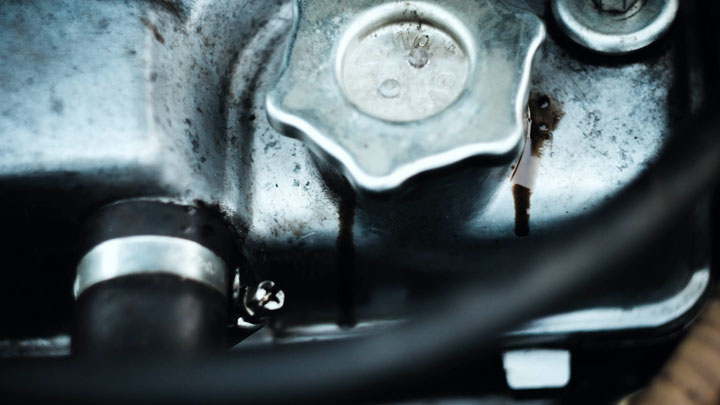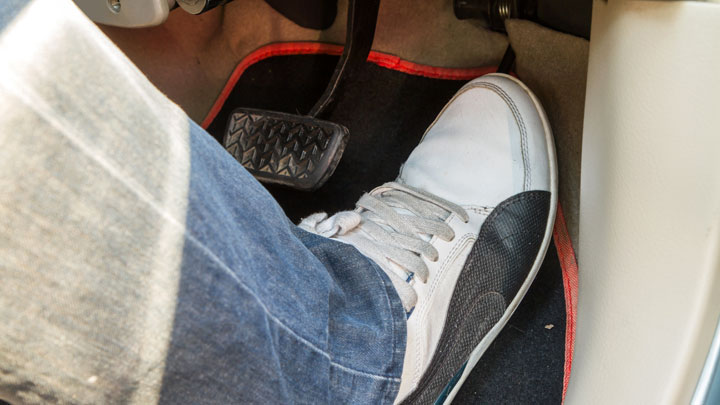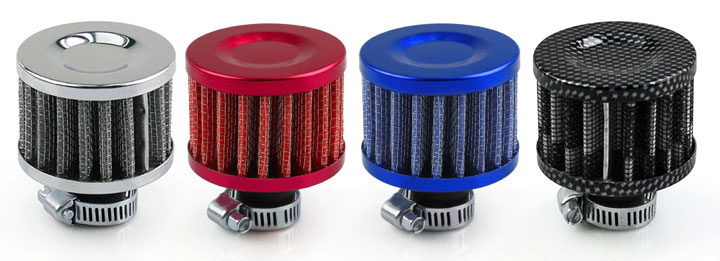Crankcase Breather Filter (How It Works, Symptoms, Replacement Cost)
Think you may have an issue with your crankcase breather filter? This inexpensive but critical engine component prevents power-sapping crankcase pressure buildup by filtering contaminants from recycled and released gases.
Keep reading to learn the symptoms of a faulty or clogged crankcase breather filter and how much it will cost to fix. The good news is that the filter is cheap and almost anyone can replace it themselves.

What Does a Crankcase Breather Filter Do?
When pressure builds up inside the engine, there are two ways to release or reroute it.
You can opt to release the pressure through the PCV (positive crankcase ventilation) valve or the crankcase ventilation filter, and in this scenario, the focus is on releasing excess gas pressure using the crankcase ventilation filter.
Typically, there is no difference in the working of the CCV filter and other types of filters in the car engine. This filter removes oil particles and other debris in the gases while releasing excess pressure on the environment.
Also, this crankcase breather filter prevents dirt from getting into the crankcase, particularly during the engine cooling process, and helps to keep your crankcase clean. Ultimately, the crankcase breather prevents oil contamination, which can have far-reaching adverse impacts on your engine.
See Also: Is a Cold Air Intake Worth It?
Where is the Crankcase Vent Filter Located?
The CCV filter usually sits on top of the valve cover or you will find it on the breather hose that is on top of the crankcase (connected to the air intake).
This section of the engine is where positive pressure is released, and air intake to and from the atmosphere takes place.
Symptoms of a Blocked Crankcase Breather Filter
Blocked crankcase breather filters can cause various issues for your vehicle, so it’s important to recognize the symptoms and address them early on. Here are some signs to look out for…
#1 – High Idle

A blocked filter affects your car idling speed.
When there is clogging on the filter, it can lead to a high idling speed. This aspect is due to the blocking or leaking of oil on the engine; therefore, a change in the idling speed is a good indication of issues with your car’s crankcase breather filter if it has one.
#2 – Oil leakage

In most cases, oil leakage is the first sign of a clogged filter.
The primary role of the filter is to prevent the entry of debris and other contaminants into the engine while easing pressure from the engine. When the filter blocks, there is a high chance of a pressure building up, and this high pressure can lead to the gasket and seals blowing up.
As a result, the oil will start to leak from your car engine or you may notice oil or sludge in your intake manifold.
See Also: Signs of a Leaking Valve Cover Gasket
#3 – Poor Engine Performance

Another notable symptom of a blocked CCV filter is a decrease in your vehicle’s engine performance.
The clogged filter affects the air-fuel, which impacts the car’s acceleration and power. You may particularly notice this issue when driving at low speeds.
However, there are quite a few other components that affect engine performance. That’s why it’s essential to consult your dealership, an independent professional mechanic, or an auto repair shop to run an exclusive diagnosis on your car.
#4 – Check Engine Light On
As with many other engine related issues, an illuminated Check Engine light is often the first symptom you’ll notice and there’s no exception here.
While the cause of the light won’t actually be the CCV filter itself (code P051F is one exception), it is the result of your engine’s ECM or PCM determining that something measurable is outside its normal operating range (where this “thing” is because of the clogged crankcase breather filter.
DTCs such as P0171 (system too lean), P0172 (system too rich), and even P0441 (EVAP system flow) can all be triggered because of a problem with your CCV filter.
Why Is There Oil Coming Out of the Crankcase Breather?
If you notice engine oil coming out from your crankcase breather filter, you may need to check your seals. Worn out seals can lead to an oil blowback in the inlet valves, which in turn leads to a pressure build-up that pushes oil back to the inlet filter.
The excess oil then pushes out through the crankcase breather filter. Also, this condition can occur due to increased crankcase pressure, which causes oil to leak beyond the oil catch can, gaskets, and seals. This CCV filter subsequently blows out this engine oil.
Crankcase Filter Replacement Cost
Best places to order parts? See: 19 Best Online Auto Parts Stores

The cost of a crankcase breather filter replacement depends on your car’s model. Additionally, there are significant price variations when it comes to the material, mounting features, filter design, and other vital aspects of your CCV filter.
Different dealerships and auto repair shops will charge different prices for them. Independent mechanics can also come to your home to replace this filter for you. But for the most part, the replacement job is simple if the filter is in an easy to access location.
On average, expect to pay around $10 to $80 for the filter. Most crankcase breather filters will be under $20 (including reusable ones such as from K&N) but some which are part of a larger assembly (such as on the Cummins 6.7 engine), will cost near the upper end of the range.
If you decide that you don’t feel comfortable replacing the filter yourself, any mechanic will be able to do it for you in a few minutes. Keep in mind that there is usually a minimum labor rate so tack on another $50 to $100 for the job.
All together, expect to pay between $60 and $180 for a professional to replace your crankcase breather filter.
Always choose a CCV filter that can withstand the extreme pressure inside the engine and one that comes with quality filter components like baseplates and filter gaskets.
These breather filters can get dirty and clogged up fairly quick so make it a point to replace it at least at the same time as when you replace spark plugs.
Causes of a Blocked CCV Filter

#1 – Clogging and Debris
Over time, your crankcase breather filter can become clogged due to dirt, debris, and other deposits. These particles accumulate and restrict the airflow, causing the filter to lose its effectiveness in relieving pressure and filtering blow-by gases.
#2 – Faulty Seals and Gaskets
A blocked CCV filter can be due to damaged or worn-out seals and gaskets. These components are critical for maintaining proper pressure levels inside the crankcase and preventing oil leaks.
#3 – Vacuum Leak
A vacuum leak can also lead to a blocked crankcase filter. When there’s a leak in the vacuum system, it can cause the engine to work harder, causing irregular idle speeds and increased crankshaft RPMs. This situation might stem from a clogged or damaged crankcase filter, as it restricts airflow inside the crankcase, resulting in a vacuum leak.
Prevention and Maintenance
Routine Checks and Cleaning
Regularly checking and cleaning your crankcase breather filter is the best way to help eliminate dirt, debris, and other deposits that can cause blockages. Make it a habit to inspect the filter during routine vehicle maintenance, such as when taking the time to change your oil or check your spark plugs.
If it appears dirty or has any visible damage, go ahead and clean or replace it as necessary.
Air Filter
The air filter plays an important role in keeping your engine clean and running efficiently (including your breather filter). Make sure you inspect and replace it as required, usually every 12,000 to 15,000 miles or as advised by your vehicle’s manufacturer.
Oil Catch Can
Installing an oil catch can is a great preventive measure for your crankcase breather filter. An oil catch can acts as an oil separator, capturing excess oil before it gets a chance to clog the filter.
By catching the oil, you’ll not only extend the life of your crankcase filter but also improve the overall performance of your engine. Be sure to empty and clean the catch can on a regular basis to make sure it’s working correctly at all times.
FAQs
What indicates a bad crankcase ventilation hose?
When your crankcase ventilation hose is bad, you might notice oil leaks around your engine, as the breather filter is responsible for preventing debris and contaminants from entering the engine. You may also experience a high idle which occurs when the airflow inside the crankcase is restricted, creating a vacuum leak and making the engine work harder than necessary.
How often should the breather filter be replaced?
In most cases, CCV filter replacement should be done every 50,000 to 125,000 miles. However, always make sure to follow your vehicle’s specific maintenance recommendations in the owner’s manual.
For example, the official filter change interval for a 6.7L Cummins engine is 67,500 miles but you’ll still want to monitor its condition and clean as needed. You should also keep an eye out for the symptoms mentioned above, as they can indicate that it’s time to replace the breather filter sooner rather than later.
Can a blocked breather filter cause engine damage?
Yes, a blocked breather filter can potentially cause engine damage. When the filter is clogged, it can restrict airflow and create a vacuum leak. This can lead to increased engine wear, oil leaks, and even engine damage over time.
- Replace the Engine or Replace the Car? (11 Factors to Consider) - Apr 11, 2024
- Plastic Piece Dragging Under Your Car? (What It Is and What To Do) - Mar 21, 2024
- Timing Belt vs Timing Chain (What’s the Difference?) - Feb 27, 2024

I have K11 Micra. It’s crankcase breather connecting the air intake filter is broken and the hose is just open to the environment. So what are consequences of let it be open? Is it only release of blow by debris to the environment?TIA
For one thing, it’s not great for the environment to do that. Some cars are tuned in such a way that any metered air that is vented to atmosphere (even from the PCV system) could cause issues with the air fuel ratio, leading to symptoms similar to a vacuum leak. I am not familiar with the Micra so I don’t know if that car has a system that is sensitive to that type of thing.
I have installed an oil catch can between the pcv valve and intake manifold on my 2016 Hyundai Genesis/G80 sedan with the 3.8L gdi motor, but I’m skeptical of installing a breather filter on the crankcase side going to the air intake tube, thinking it might cause a vacuum leak. If I plug the air intake tube fitting, will I be able to install a crankcase breather filter without worrying about vacuum leaks? Please help
I’m not real familiar with G80s, but I know Subarus don’t handle PCV venting well without being tuned for it. For instance, an IAG competition AOS requires a tune because it vents air from the PCV system to atmosphere. Your catch can setup sounds similar to me. IAG’s street series AOS on the other hand recirculates that air from the crankcase back into the intake.
Speed density setups (cars that use MAP sensors instead of MAF sensors) tend to be a little better at handling that kind of change without any aftermarket tuning. If your fittings are tight enough, you shouldn’t have to worry about vacuum leaks per se, but you might need to be concerned about venting metered air that is supposed to go back into the intake. This could throw off the air fuel ratio if the car is unable to adjust for the change on its own. Just something to look into, hope this helps.
This information is very useful. 1990 Ford E150, 5.0, 8 cylinder. I have oil coming out of the valve cover pipe that goes to the air filter breather element. You say that this could be a problem with seals failing. Which seals are you referring to? Thanks so much for your help.
There is often a seal or grommet around the PCV valve. Could this be the leak you are experiencing?
It very nice explanation madam. Clearly understood this topic. Thank u madam. To keep this in another topic u will send it from Google. Cover the all the engine parts. Clearly thoroughrized in this topic mam.
Thank you for the suggestions. Good and informative post. Thanks again for sharing this post.